The yam ring served in Chinese restaurants is also known as taro basket or prosperity yam basket. But what exactly is it?
It’s a ring of fried mashed yam with a large hole in the center, filled with stir-fried dishes such as kung pao chicken, sweet and sour pork, or some vegetarian stir-fried. The yam ring is usually presented by placing it on a bed of fried rice vermicelli.
In this article, I will make a yam ring that can be used as one of the Chinese New Year feasts. I will also include a recipe for kung pao chicken, which you can put inside the ring. However, you can choose to put any item you like in it, according to your preference.
The original Chinese name for this dish is “佛钵飘香,” which loosely means “aromatic food served in a Buddha bowl.” The reason for this name is unclear, though some suggest that the shape of the yam ring resembles a Buddha bowl. A Buddha bowl is an empty bowl carried by Buddhist monks, and people they encountered on their journey would share food by placing a portion in the bowl.
Due to the tedious work involved, the yam ring is usually made during special occasions. People who cook stir-fried chicken or pork will serve it on a plate instead of making a yam ring to contain it during normal days. However, its artistic presentation makes it popular during special occasions or festivals, such as the Lunar New Year.
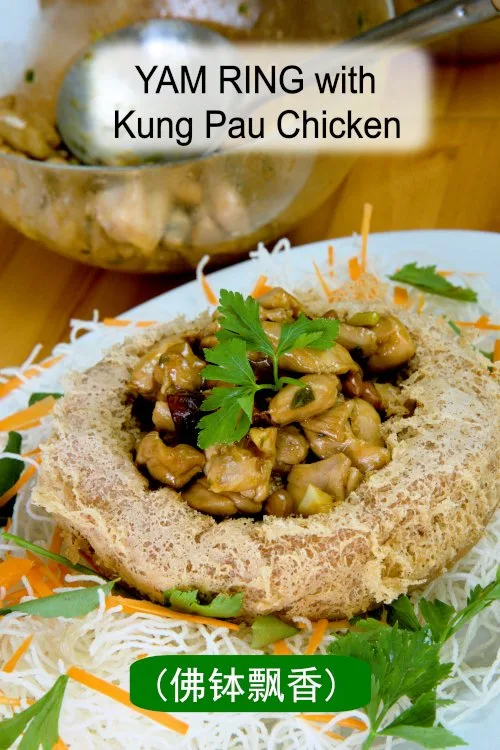
Note: This post may contain affiliate links. Please read my privacy policy for more info. I may receive commissions for purchases made through links in this post. As an Amazon Associate, I earn from qualifying purchases.
Yam or Taro?
Before I proceed with preparing the yam ring, I need to highlight the confusion around the terminology. The words yam and taro are often used interchangeably in different translations of this recipe. The ingredient is 芋头 in this recipe. Nonetheless, when I communicate with most Chinese people, they refer to taro and yan as 芋头. As such, I will refer to this dish as either a Yam Ring or a Taro Basket, but in the ingredient list, I will mention taro, which is the correct English word based on my understanding. If you have any answer regarding this, I would appreciate it if you could enlighten me by leaving your answer in the comment section.
Here is how to prepare the yam ring (taro basket)
a. Steam the taro
The major ingredient for the yam ring (taro basket) is taro.
- First, remove the skin of the taro and slice it thinly or into cubes to increase the surface area for effective steaming.
- Next, set up the steamer and steam the taro over high heat for about ten minutes. Once steamed, use a chopstick to check if the taro slices are soft and easy to pierce. If not, steam for a few more minutes until they turn soft.
- Transfer the steamed taro to a mixing bowl and season it with Chinese five-spice powder, salt, sugar, and ground white pepper. The exact quantity of each seasoning can be found in the recipe at the end of the article.
- Finally, mash the taro slices and mix them well with the seasonings.
b. Prepare the wheat starch paste
The second step is to make a starch paste to bind with the mashed yam.
- Mix the wheat starch and hot water in a separate bowl. The hot water will partially cook the starch to become a wheat starch dough.
- Next, combine the wheat starch dough with the taro paste until they are mixed well. You can wear gloves to knead the mixture, like kneading bread dough.
- Once it becomes homogenous, knead the shortening and baking soda into the taro paste until it forms a smooth dough that no longer sticks to the mixing bowl. The shortening can be replaced by lard, margarine, or butter.
- Then, divide the dough into two portions, as this recipe is for two medium-sized taro baskets.
- Finally, transfer the dough to an air-tight container or wrap it with cling film and place it in the freezer for half an hour to one hour until it becomes firmer. This firm texture is necessary to shape the dough into a ring.
Note: Wheat starch should be available in most Asian grocery stores.
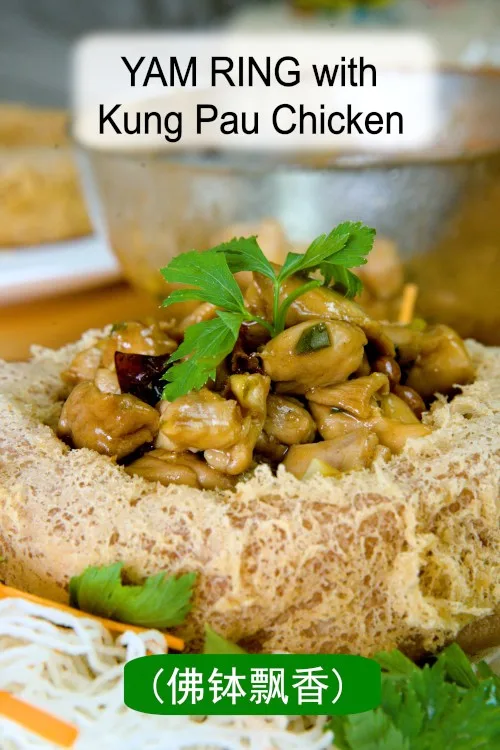
c. Shape the yam ring
The third step is to shape the ring.
- Remove the taro dough from the freezer when it is firm enough to shape into a ring.
- Sprinkle some wheat starch or flour over a chopping board or pastry mat.
- Place the dough on the surface, and then push your thumb through the center of the dough to create a deep indent.
- Flip the dough over and repeat the process on the other side. Eventually, the top and bottom indents will meet to form a hole at the center, giving it the appearance of a doughnut.
- Next, use your finger to push the dough outward away from the hole until it forms a large ring with a thinner wall. Shape it until it becomes a perfect ring with equal thickness.
Note: We made a video of how to make the yam ring. Please refer to the video placed after the recipe in the article.
d. Deep-fry the rice vermicelli
We also need some fried rice vermicelli (mee hoon) for decoration. Usually, I will fry the rice vermicelli first, then use the same oil to fry the yam ring.
- Pour vegetable oil into a wok enough to submerge the yam ring. (Yes, it does require plenty of oil.)
- To check if the oil temperature is correct, break a small section of rice vermicelli and throw it into the oil. The oil temperature is suitable if the rice vermicelli expands and floats on the surface immediately.
- Then, place all the vermicelli into the hot oil. All the vermicelli will expand immediately and take up the space of the whole wok within two to three seconds.
- Immediately remove all the vermicelli from the wok with a strainer.
- Place the rice vermicelli on large serving plates. Garnish with coriander leaves and carrot strips.
e. Deep-fry the yam rings
Now deep-fry the yam ring with the same oil after frying the rice vermicelli.
- Heat the oil until it reaches a temperature of around 160°C. If you don’t have a kitchen thermometer, place a wooden skewer or chopstick in the oil to check the temperature. When you see a stream of bubbles rising from the wooden chopstick, the oil temperature is correct.
- Place the yam ring on a strainer with holes and slowly lower it into the hot oil. If any part of the yam ring is not submerged fully, use a large spoon to scoop the oil and continuously pour it onto the upper part. However, if you use enough oil, you won’t need to do this.
- Keep deep-frying the yam ring until it turns golden brown and the fluffy strands start to firm up. Once it’s cooked, remove the yam ring from the oil and place it on the bed of fried rice vermicelli.
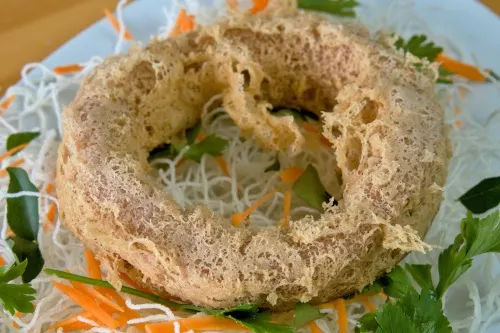
f. Fill up the yam ring with kung pao chicken
As I mentioned, you can stuff the yam ring with any stir fry or vegetarian filling. In most restaurants, the common stir-fry options for the yam ring are Kung Pao Chicken or Sweet and Sour Pork, and you can find both recipes on this food blog.
To complete this recipe, I have also created a video demonstrating how to make the yam ring filled with Kung Pao Chicken. You can find the video just after the recipe.
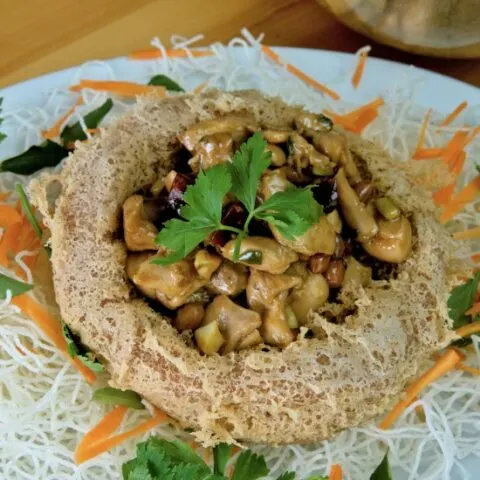
Yam ring with Kung Pao chicken
Make a crispy yam ring (prosperity taro basket/佛钵) filled with Kung Pao chicken for special occasions—a traditional Chinese recipe.
Ingredients
Ingredients A
- 300g yam, thinly sliced
- 1 tsp five-spice powder
- 1 tsp salt
- 1 tsp sugar
- 1/8 tsp ground white pepper
Ingredients B
- 60g wheat starch
- 90ml hot water
- 30g of shortening
- 1/2 tsp baking soda
Ingredients C
- 35g rice vermicelli
- Coriander leaves
Instructions
Steam the taro
- First, remove the skin of the taro and slice it thinly.
- Steam the taro over high heat for about ten minutes until it turns soft.
- Transfer the steamed taro to a mixing bowl and season it with Chinese five-spice powder, salt, sugar, and ground white pepper.
- Finally, mash the taro slices and mix them well with the seasonings.
Prepare the wheat starch paste
- Mix the wheat starch and hot water in a bowl and stir until it forms a dough.
- Combine the wheat starch dough with the taro paste until they are mixed well.
- Knead the shortening and baking powder into the taro paste until it forms a smooth dough that no longer sticks to the mixing bowl.
- Then, divide the dough into two portions. Transfer the dough to an air-tight container and place it in the freezer for half an hour.
Shape the yam rings
- Sprinkle some wheat starch or flour over a pastry mat.
- Place the dough on the surface, and then push your thumb through the center of the dough to create a deep indent.
- Flip the dough over and repeat the process on the other side. Eventually, the top and bottom indents will meet to form a hole at the center, giving it the appearance of a doughnut.
- Next, use your finger to push the dough outward away from the hole until it forms a large ring with a thinner wall. Shape it until it becomes a perfect ring with equal thickness
Deep-fry the rice vermicelli
- Pour vegetable oil into a wok enough to submerge the yam ring.
- Heat the oil. The oil temperature is suitable if the rice vermicelli expands and floats on the surface immediately.
- Place all the vermicelli into the hot oil. All the vermicelli will expand immediately and take up the space of the whole wok within two to three seconds.
- Immediately remove all the vermicelli from the wok with a strainer.
- Place the rice vermicelli on large serving plates. Garnish with coriander leaves and carrot strips
Deep-fry the yam rings
- Heat the oil until it reaches a temperature of around 160°C.
- Place the yam ring on a strainer with holes and slowly lower it into the hot oil.
- Keep deep-frying the yam ring until it turns golden brown and the fluffy strands start to firm up. Once it's cooked, remove the yam ring from the oil and place it on the bed of fried rice vermicelli.
- Stuff the yam ring with any stir fry of your choice.
Recommended Products
As an Amazon Associate and member of other affiliate programs, I earn from qualifying purchases.
Nutrition Information:
Yield: 2 Serving Size: 1Amount Per Serving: Calories: 449Total Fat: 16gSaturated Fat: 6gTrans Fat: 0gUnsaturated Fat: 9gCholesterol: 8mgSodium: 1497mgCarbohydrates: 71gFiber: 7gSugar: 3gProtein: 6g
This data was provided and calculated by Nutritionix on 12/10/2023




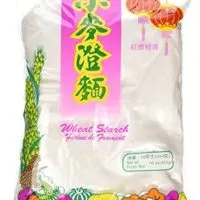
Renee Chang-Way Chang
Tuesday 12th of December 2023
Muchas gracias Sr Kwan Kwam por compartir la receta, Excelente Chef mis sinceras felicitaciones, voy a ser su fiel seguidora. Soy peruana y me gusta cocinar y busco siempre nuevas receta , y tuve la suerte y el honor de ver su portal. Muchas gracias por la explicación tan clara y con mucho profesionalismo. Bendiciones.
Mg
Monday 11th of December 2023
Yutou 芋頭 is taro in English :) Yam is a very general word that can refer, at least in the States, to various types of sweet tubers, including sweet potatoes
KP Kwan
Monday 11th of December 2023
Hi, this is KP Kwan. Thank you for reading my recipe. Please feel free to ask any questions or leave comments. I’ll respond as soon as possible.
Renee Chang-Way Chang
Tuesday 12th of December 2023
@KP Kwan, Al principio no sabia que era el Taro hasta que vi la preparación . Aca en Perú lo conocemos como pituca en la región de la selva y aca en la capital de Perú en el ambiente chino como Sacco. Nuevamente mil gracias.